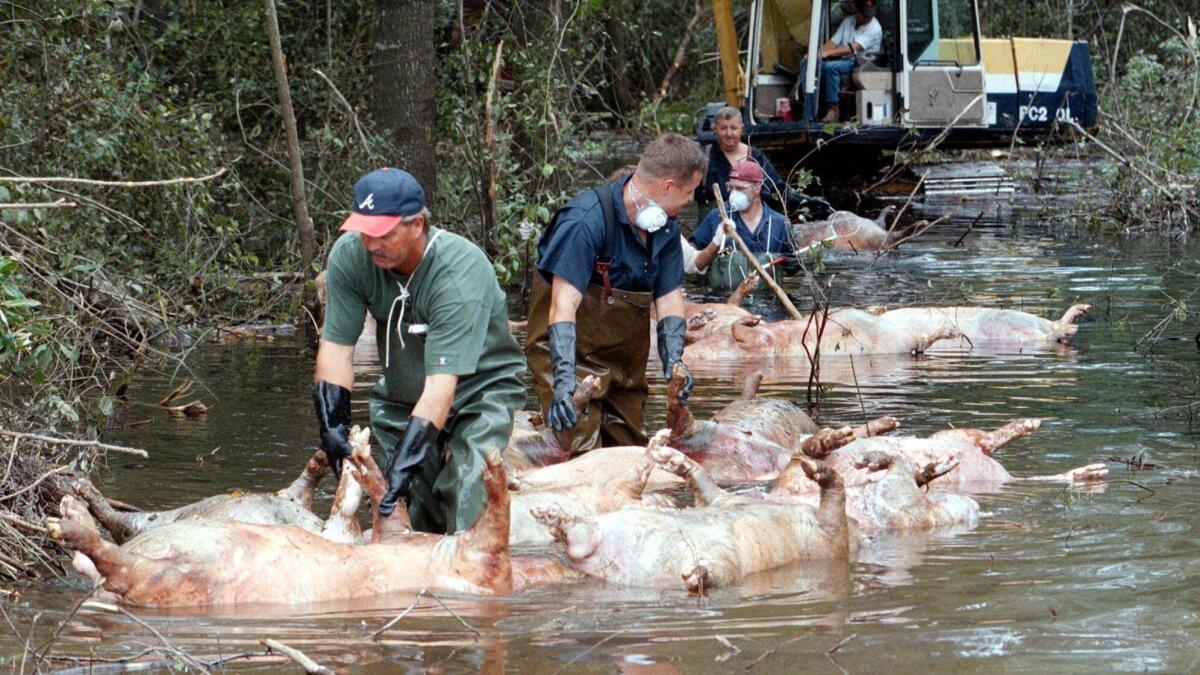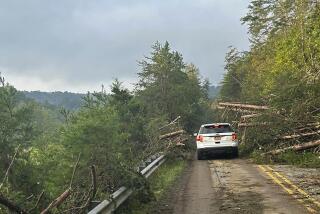As Hurricane Florence approaches, environmental disasters in North Carolina loom

Reporting from Elizabeth City, N.C. — Whipping winds and surging ocean waters won’t be the only threats from Hurricane Florence, which is expected to make landfall in North Carolina on Friday.
Rain and rising floodwaters could swamp coal ash basins and hog waste lagoons, washing the byproduct of the state’s industries into rivers and lakes. Environmentalists warn of toxic chemicals, bacteria and other dangers.
If that happens, some of the damage from this natural disaster would have a distinctly man-made component, echoing problems from previous storms.
During Hurricane Floyd in 1999, flooding breached the open-air lagoons where farmers dump waste from their hogs. The runoff can cause havoc in the ecosystem, creating algae blooms and killing fish.
The industry said it’s been preparing for Florence. Because the manure can be used as fertilizer, the North Carolina Pork Council said hog farmers have been tracking storage levels to ensure they could handle inundation from the storm.
“The preparations for a hurricane began long before the past few hours or days,” Brandon Warren, the council’s president, said in a post on the organization’s website. “Our farmers take hurricane threats extremely seriously.”
Many lagoons can handle at least 25 inches of rain, Warren said. But that capacity will be tested given forecasts for unusually heavy rainfall and the potential for additional flooding.
Environmentalists said coal ash presents another threat.
Although North Carolina doesn’t have coal mines of its own, it relies on electricity generated by burning coal. The process creates coal ash that Duke Energy, the state’s dominant utility, has traditionally mixed with water and dumped into unlined basins.
Some of those are near rivers that could overflow or in floodplains that could become inundated, said Frank Holleman, a senior attorney at the Southern Environmental Law Center.
“This ash is stored primitively, and in the most risky way,” he said. “It’s sitting there, ready for catastrophe if something hits it.”
Holleman said the company is dragging its heels in addressing the problem, a criticism rejected by Paige Sheehan, a spokeswoman for Duke Energy. Two of the company’s 31 coal basins have already been excavated and shut down, she said, and they’re phasing out the rest. The seven largest basins, which hold 70% of the company’s ash, will eventually be capped.
“We got a head start on a lot of the industry,” Sheehan said. “We think that positions us well going into the storm.”
Duke Energy pleaded guilty in 2015 to criminal violations stemming from a spill that dumped 39,000 tons of coal ash and 27 million gallons of slurry into the Dan River. But that wasn’t related to a hurricane, and Sheehan said the company is prepared for Florence.
There are four sites considered at risk from the storm, and together they hold roughly 17 million tons of coal ash. Because the company has already started closing down the basins, she said, water levels are lower and can handle the heavy rainfall that Florence is expected to drop on the state.
Staff and equipment have been positioned at coal basins near the coastline, and inspections will be conducted on foot, from boats and from the air with drones.
More to Read
Sign up for Essential California
The most important California stories and recommendations in your inbox every morning.
You may occasionally receive promotional content from the Los Angeles Times.










